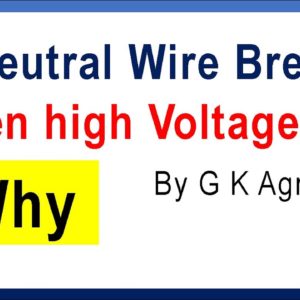Today I will explain, over voltage problem in the houses, due to breaking of neutral wire, over voltage in the AC supply, in the houses, may be due to many reasons, but today I will explain, the over voltage problem, in AC supply, due to problem in neutral wire, here I have shown simple circuit, there are 3 houses, this is house number 1, shown using green color, this is house number 2, this is house number 3, these 3 houses have load R1, R2, and R3, All houses will get single phase power, but this single phase power , is generated from 3 phase power, here I have shown 3 phase power, it is neutral wire, and these 3 are 3 phases, this is line R, this is line Y, and this is line B, voltage between Line & N, will be 230 volts. similarly, voltage between this line R, and neutral will be 230 Volts, and voltage between Y phase line wire, and neutral also will be 230 volts. but voltage between line to line, will be 400 V, so this is 400 volts, then between R & B also 400 V, and between line Y and line B, voltage will be 400 volts, but house will get only 230 V supply, see this is line wire, this is neutral wire, voltage between line & neutral, is 230 volts, so this is 230 volts, similarly this house also will get 230 V, but from phase Y and Neutral, this house also will get 230 V supply, this is line wire, and this is neutral wire, so Neutral (N) is common, but line wires are different, each house is getting supply from, different phase of 3 phase supply, one getting from R phase, another is getting from Y phase, and 1 more house, is getting from B phase, now suppose, in this house, wire is breaking here, so I break the neutral wire, now neutral wire is broken, so no neutral connection, will go to this house, so this house will not have any power, only line wire will come, and over voltage will not be there, now suppose, neutral wire breaks here, like this, so no neutral wire will go here, but still, these 2 houses will get supply, I will tell how?, like this, so this line to line voltage, 400 V, will be shared by these 2 houses, and these 2 houses, may have over voltage, how they will get over voltage?, I will explain now, this circuit, I have shown here, this line R is this, this line wire Y is this, this resistance R3 is this, this load R2 is this, so line R, then R3 load, then R2 load, then Y, this is here line R, R3 load, then R2 load, then Y, this circuit, and this circuit are same, and this 400 volts, is shown here, now You see, this load R2, and R3 are in series, connected across 400 volts, so this 400 volts, will be shared by R2 and R3, if these 2 resistive loads are equal, then equal voltage will come here, and here, if it is 400 volts, we get 200 volts here, 200 volts here, but if these resistance, are not equal, say R3 is 100 Ohms, and R2 is 300 Ohms, then you will get only 100 volts here, less voltage means less voltage, in series connections, R2 is more 300 Ohms, so we get more voltage here, 300 V, so house with R2 load, will have over voltage 300 volts, and house 3 with R3 load, will have less voltage, under voltage, only 100 volts, so 1 house is having over voltage, another is having under voltage, but both are the problem, if we have the over voltage, then electronic equipment may fail, if we have under voltage, then motors in the fan and fridge, will have the problem, now suppose, Neutral wire is breaking here, not here, so I will break it here, now neutral wire is not going, to any house, but still, all houses are getting power, see this house, gets the power like this, and like this, so current in this load, is flowing this way, and this way, similarly current in this load, is flowing like this, and like this, similarly current in this load, is flowing like this, and like this, so all houses are getting power, but some houses have less voltage, some houses may have over voltage, now this single wire of phase Y, is going to only 1 house, but in actual case, there may be many houses, so same line wire, will go to some other house also, say one more here, so this house, and this house will be in parallel, so these 2 loads will be in parallel, so like that these loads, will be in series and parallel, so if you change the load any where, say here, this will affect, the voltage distribution, across all houses, so voltage across all houses, will change, so if some one, change the load in 1 house, other houses, will see the fluctuation in voltage, today we will close now,


